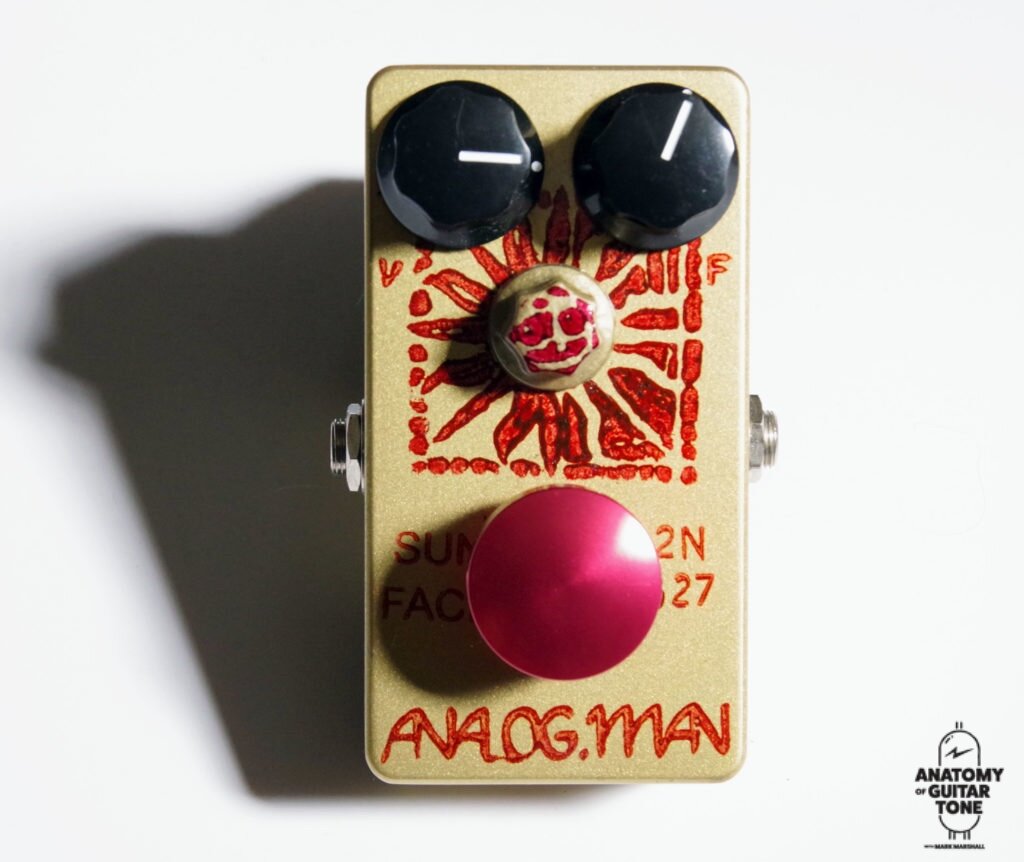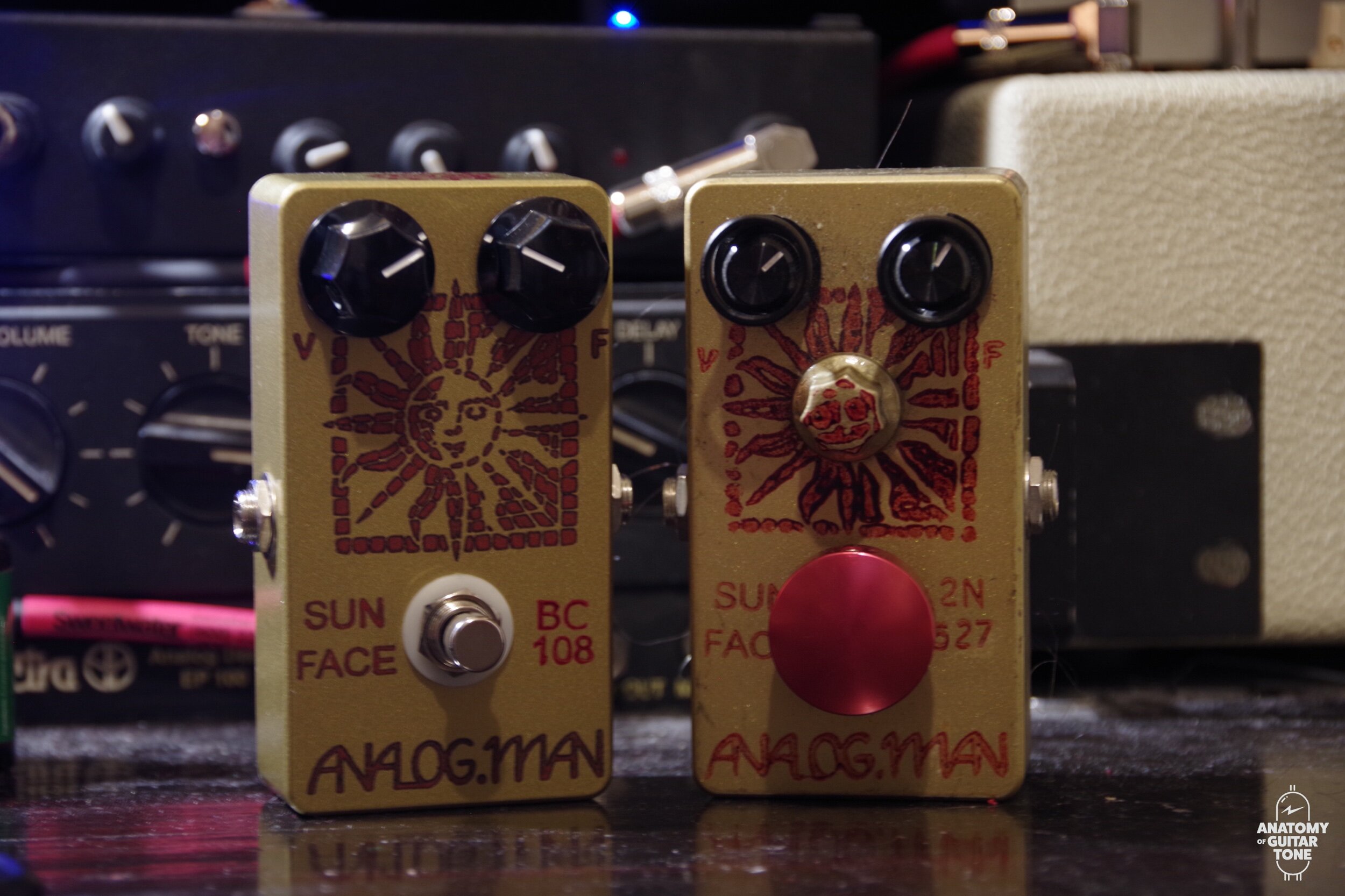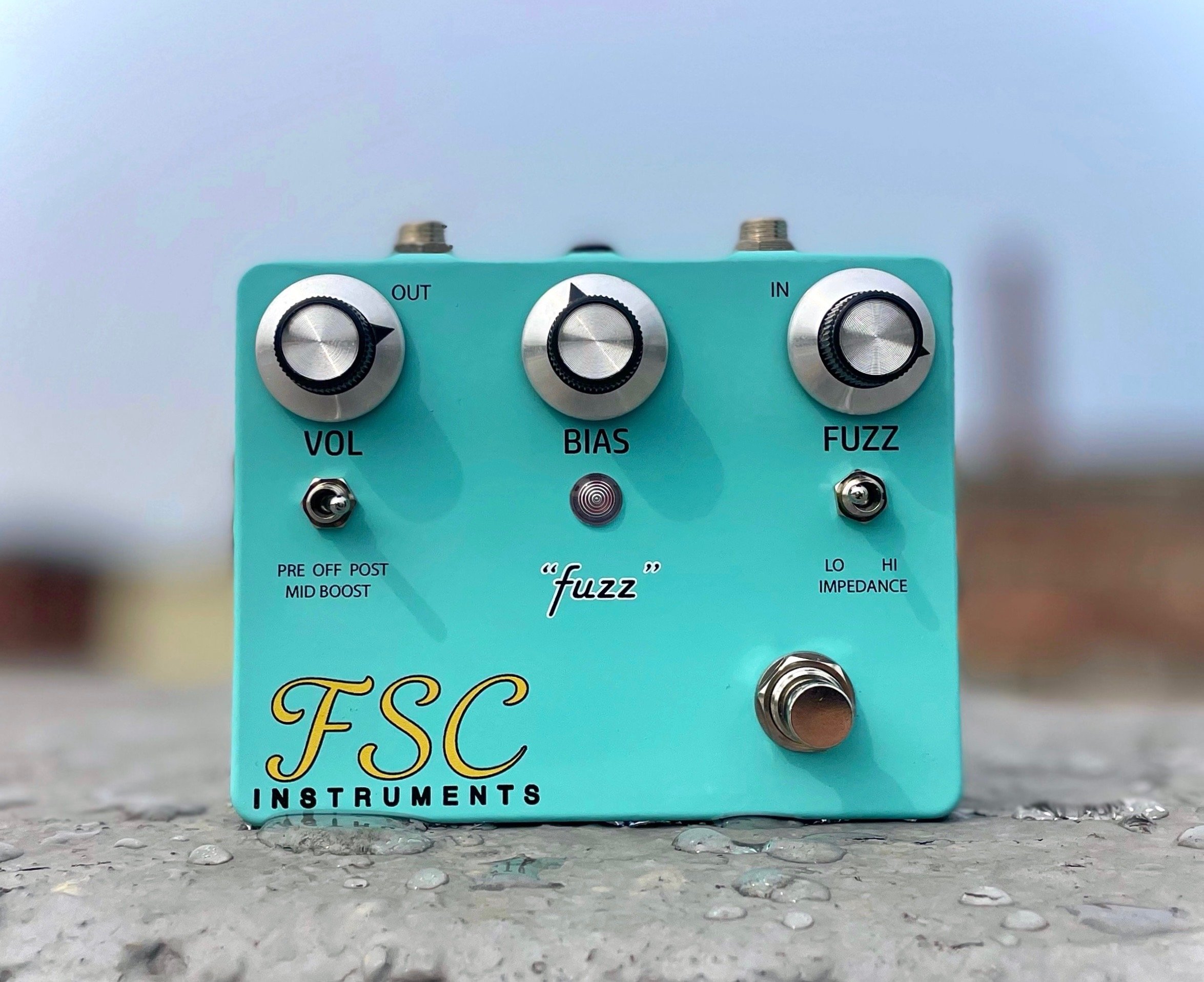Analog Man Sun Face BC108
Along with the Big Muff, the Fuzz Face circuit is the most well-known fuzz circuit—largely through its use by Jimi Hendrix and David Gilmore.
Hendrix used other fuzz pedals from time to time, but he became associated with the Fuzz Face, most likely from his performance at Woodstock. I actually got to hold the Fuzz Face and wah-wah Hendrix played at Woodstock. I was thoroughly patted down as I left the storage location.
“Fuzz Face” has become a generic term for fuzz among some guitarists. Some of the major manufacturers don't help with this marketing confusion. We’re led to believe that there’s one basic Fuzz Face, which isn’t true. I'm not saying Dunlop is lying to you. I'm saying they're making a vanilla Fuzz Face in the hope that it fits all.
What's wrong with “simple,” or with serving a mass audience? Well, I suppose if the pedals sounded accurate, I wouldn't care. But as is so often the case, these pedals only approximate a tone. They don’t nail it.
Approximating a guitar tone has never satisfied me. When I got my first mass-produced Fuzz Face, I was disappointed. It turned me off of fuzz. I didn't understand how this could be Jimi’s tone.
If my first fuzz pedal had been an Analog Man Sun Face, my experience would have been entirely different.
Forks and knives
There is a fork in the road when it comes to Fuzz Face tones. The first Fuzz Faces used germanium transistors. In the late 1960s, Dallas Arbiter switched to more stable silicon transistors.
1968 Dallas Arbiter Fuzz Face
The difference between these two transistors is more significant than you might expect—not only in their dynamic response but also in their overtones. I think of them as fraternal twins.
There are variations even within these two types of transistors.
Years ago, I was on the search for a modern, authentic Fuzz Face. Once I started searching, it was a pretty straight line to Analog Man. Mike is the world expert on many circuits, especially the Fuzz Face. Analog Man has a whole web page dedicated to the variances that transistors create in the Fuzz Face circuit. Mike's Sun Face is the go-to pedal for those who have a genuine love for the original Fuzz Face circuit and have experienced the tone of the vintage models.
BC108C
In this article, I'm going to focus on the feel and sound of the Analog Man BC108 Sun Face. (I’ve written previously about the Analog Man germanium-based Sun Face.)
The Fuzz Face was made with NKT275 germanium transistors from 1966 thru 1968. In 1969, Dallas Arbiter switched to silicon transistors because they’re more consistent than germanium, which doesn’t love the heat. As the temperature changes, so does the sound of a germanium-based fuzz pedal.
Hence the switch to silicon—it’s more stable. This came with tonal changes, though.
On paper, the Fuzz Face isn't a complicated circuit. You might wonder what the real difference is between a Dunlop re-issue Fuzz Face and an Analog Man Sun Face. Well, there is a lot of difference, and it isn't subtle.
Testing and matching components is crucial on fuzz pedals. Mike Piera has dedicated an incredible amount of time testing and matching various transistors and capacitors. Everything about transistors gets tested. He is to transistors and capacitors what a wine taster is to wine.
This is important, because fuzz pedals need some coddling to sound right. To mass produce its fuzz pedals, Dunlop has made sacrifices in its choice of transistors, matching, and testing. This may not seem like a big deal, but it is!
Analog Man offers several options in transistors for its germanium and the silicon models that are worth considering.
On the Dark Side
One of the most well-known applications of the BC108 is Pink Floyd's Dark Side of the Moon record. David Gilmour used a BC108 silicon Fuzz Face paired with a Colorsound Power Boost into a Hiwatt DR103 amp.
David Gilmore in the 1970s with a silicone Fuzz Face
Sound
To my ears, one of the noticeable differences between my germanium 2N527 Sun Face and my BC108 Sun Face is the way each treats the fundamental frequency.
Ok, that's starting to sound a bit technical and nerdy. Think of it this way. If you hit an E note, you hear that note, but you also hear the harmonics around it. Specific fuzz or gain pedals can either accentuate the fundamental frequency of a note or the harmonics around it.
The germanium Sun Face is more abundant in its harmonic overtones. Depending on where your volume knob is placed, you can hear some ring modulation-like effects ghosting in your tone.
These harmonic ghosts aren't as present on the BC108 silicon Sun Face. The BC108 is more focused on the fundamental tone—the E note, in our example.
There are situations where you may prefer less harmonic ghosting. When you want a more "direct" fuzz tone, the BC108 gives you that. Not that it isn’t harmonically rich. It's a very full-sounding fuzz. But, the spotlight is on the fundamental tone.
Eddie Hazel can be heard using a silicone Fuzz Face on “Maggot Brain” by Funkadelic
Volume knob
Guitarists who lean on the Fuzz Face for their base tone (meaning they’re almost always on-pedal) are in love with how a germanium Fuzz Face cleans up. My germanium Sun Face 2N 527 has a clean sound like no other.
I can get so many variations in color by rolling the volume knob back. If I roll the volume back enough, I can get a completely clean sound with light compression and a treble roll-off that is extremely flattering to the guitar.
In fact, many guitarists think Jimi only used a Fuzz Face on his distinctly fuzzy songs. In reality, he was using a germanium Fuzz Face a lot, with the volume rolled back. A Fuzz Face paired with a Marshall Plexi is a thing of beauty!
A silicon Fuzz Face circuit doesn't work the same way. You don't get as many colors when rolling the volume knob back. It reacts very differently. This isn't a bad thing per se. For instance, you may not be looking for that much volume interaction.
Interior of the Analog Man BC108
Analog Man added a great feature on both the germanium and silicon Sun Face. Because Mike understands the importance of volume knob interplay, there is an internal adjustment to set the input volume to the fuzz.
In the event you want your Sun Face to sound like your guitar volume is on 6 without turning your guitar to six, you simply turn down the trim pot inside the pedal. This is ideal for those making fast changes with a pedalboard between sounds and who are primarily using the Sun Face for a cleanish tone.
Warmth
Guitar tone is very much about pairing elements. The word “warm” gets thrown around a lot in way that makes guitarists think warm is better. But it’s all situational. It all depends on the guitar you use, the amp you use, the microphones you use, the preamps you use, the style of music you make, and your own personal touch. A dark amp with a dark fuzz and humbuckers equals a muddy tone.
Many characterize a silicon fuzz as brighter. My BC108 definitely has more gain then the germanium Sun Face, but it’s also pretty fat. It’s not nearly as bright as a Univox Super Fuzz. It’s also not devoid of midrange, the way a Big Muff is. The midrange emphasis seems to be toward the lower end of the spectrum with the BC108, whereas it tends to be higher on the spectrum with the germanium. The frequency curve is shifted.
Feel
Depending on the fuzz circuit, you may notice a difference in feel. I tend to think of some fuzz pedals as loose and some as sticky. Not all fuzz pedals have the same feeling when it comes to attack.
Vick Audio Big Muff circuit
For instance, Tonebender circuits feel stickier to me than a Big Muff. A Tonebender is punchy. You can feel the fuzz grab the signal while letting the initial transient pass through. A Big Muff is looser or mushier when you play a note, and doesn't allow as many transients to pass.
As you might expect, that variation doesn't just follow different circuits. I find that the silicon and germanium Sun Faces feel slightly different from each other.
Germanium Sun Face
To me, the germanium Sun Face is stickier than the silicon. The silicon is more even and balanced. The germanium is wilder, allowing some notes to pop out more than others. There is a certain raggedness with the germanium, whereas the silicon sounds more controlled.
I can't really compare the BC108 to any other silicon fuzz. I would have to say it's the most balanced of the silicon fuzz pedals I've used. I often reach for an EQ when using a silicon fuzz. But the BC108 sounds great even into a clean Fender Blackface amp.
Snap, crackle, pop
When using fuzz, I find that when I need my guitar to pop through a mix a little more, I will lean toward a "sticky" fuzz. Which translates to more attack before the fuzz takes over.
It's similar to an attack knob on a compressor, which allows you to dictate how much of the signal passes through before it gets compressed.
There isn't a setting for this on fuzz pedals. But I find that some circuits have more attack than others.
There are times when you don't want more attack. You may want a wall of fuzz without notes popping out. Too much attack may be distracting. See why you need more than one fuzz?
Bias
Along with an internal adjustment that controls the input volume, the BC108 also has an adjustment for bias. By turning the bias really low, you can get a cool, gated fuzz effect.
Making decisions
Whenever I'm preparing for a gig or dialing in a guitar tone for a session, I audition a few fuzz pedals. All of the elements have to speak to each other. The guitar, fuzz, and amp all interact.
Even simple things like how loud I have my tube amp create a lot of tonal change when using fuzz pedals. The art of getting great fuzz tones goes beyond just picking a fuzz.
Analog Man discusses this on his website. More than any other pedal, fuzz pedals require close interaction with guitar, pickups, and amp. This takes some getting used to.
There are fuzz pedals and there are FUZZ pedals. There’s a reason an Analog Man will always be pedal on my board.
Examples
For these examples, I recorded a variety of guitar amps with an AEA A840 and Soyuz Bomblet into API 312 mic preamps into a UAD Apollo. I'm using UAD's LUNA DAW.
All the guitar amps are running through an AmpRX Brownbox to maintain voltage. I like to keep my amps around 117v.
I also used the IsoAcoustics Stage 1 Board to decouple my amps from the floor to reduce any unwanted resonance in the recording. With all guitar tones, small steps are cumulative.
Marshall SV20H amp with 2x12” closed back cab loaded with Celestion Greenback 25s.
Vox AC15 with Alnico Blue speaker
Victoria 518 tweed Champ
Headstrong Lil’ King Reverb blackface Princeton
Harmonic overtones
I mentioned that the germanium version of the Sun Face has some ring modulation-like overtones at some settings. Listen to this comparison of the overtones on the germanium Sun Face to the Silicon Sun Face.
Here are two tests to determine if you can hear the difference between germanium and silicon.
Bias
Examples of rolling back the internal bias adjustment for a gated fuzz.
If you have further questions or want to chat about gear, feel free to reach out.

















